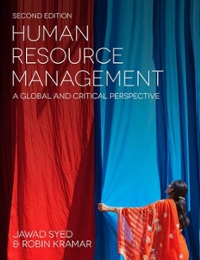When ANZ, one of Australia's leading banks, advertised 55 jobs at its new Manila operation, ranging from
Question:
When ANZ, one of Australia's leading banks, advertised 55 jobs at its new Manila operation, ranging from a new head of human resources to credit-risk officers and business analysts, not a single job was advertised in Australia. Almost all jobs were classified as high skilled, requiring a high level of university education, two years of similar experience, and fluent written English (Wade and Hawthorne, 2012). The example reflects the trend of the major Australian banks, Westpac, NAB, and ANZ, to carry out functions overseas (Yeates, 2012).
Lower overseas wages that translate to lower business costs are a major reason for the decision to head overseas to source labour. As a high-wage developed nation, Australia struggles to compete with wage costs in developing nations. An Australian-based credit risk officer with the National Australia Bank told The Saturday Age, for example, that the wage for this position in Australia would be around \(\$ 60,000\) a year, ranging up to \(\$ 80,000\) for someone with more experience. In Manila, on the other hand, jobs for credit-risk officers working for overseas banks are being advertised at 20,000-30,000 Philippine pesos a month, equivalent to about \(\$ 5000-\) \(\$ 7800\) a year. These jobs are skilled positions that require a university education and a minimum of four years of similar experience (Wade and Hawthorne, 2012).
New technologies have also meant that offshored work can be more easily transferred to home countries and communicated to other international sites. Technological innovations expand the range of activities that can be outsourced with an increasing number of service-sector jobs suitable for offshoring (Graham, 2012). Modelling commissioned by several unions, including the one representing the financial-sector workers, the Financial Sector Union (FSU) have predicted that at least 250,000 jobs across Australia's service sector are susceptible to outsourcing over time, especially in finance, telecommunications, and IT (Wade and Hawthorne, 2012).
A further reason given for the increase in offshoring is the Australian skills crisis that threatens business growth and expansion. If it is not possible to cater for business needs in Australia, then companies look elsewhere, especially when overseas wage rates are lower and potentially provide a greater return on investment (Graham, 2012). The increasing incidence of offshoring and the emerging sophistication in offshoring operations raises the sourcing of labour from overseas as a viable option for more organisations. The decision does however require considerable forethought, and it can take several years to successfully prepare and execute an offshoring initiative.
The big Australian banks have approached the offshoring of labour in different ways. NAB and Westpac have outsourced operations to specialist business-processing firms that have established reputations. ANZ on the other hand directly employs staff in lower-cost Asian countries as evidenced by the 'operations hubs' in Manila and the Chinese city of Chengdu and the long-established centre in Bangalore. ANZ chief Mike Smith has emphasised the importance of these operations hubs, which facilitate ANZ's operations across Asia, not just Australia. 'Our investment in our operations hubs continues to support our productivity agenda, and we're also placing a stronger emphasis on generating on-going efficiencies given the more constrained conditions.... This isn't a matter of reacting to events, but of dynamically managing our costs to reflect our business strategy and the market conditions' (Wade and Hawthorne, 2012).
There has been a lot of negative press about the impact of these outsourcing and offshoring strategies on Australian jobs with the FSU pushing for regulations to make offshoring more difficult for banks. Former Westpac chief Gail Kelly deflected negative perceptions by shifting the discussion of outsourcing to one of 'best sourcing'. 'It's called best sourcing rather than outsourcing because in some cases we insource as well.' A spokesman for National Australia Bank has also noted that with a workforce of 44,000 worldwide, numbers 'will fluctuate in various parts of the business at times due to the completion of programs, outsourcing of some projects and continuing focus on efficiency.' He said NAB always tried to redeploy people within the business if possible (Wade and Hawthorne, 2012). These comments reflect the need for financial institutions to become flexible and pragmatic in their decisionmaking about where they source labour and to remain responsive to changes in demand for their product.
Questions
1 As explained in the case, NAB and Westpac have outsourced operations to specialist business-processing firms, whereas ANZ directly employs staff in the targeted location. What would be the advantages/disadvantages of each approach?
2 What sort of jobs are best suited for offshoring?
3 What controls would an organisation need to put in place when offshoring work to ensure that jobs requirements are met?
Step by Step Answer:

Human Resource Management A Global And Critical Perspective
ISBN: 9781137521620
2nd Edition
Authors: Jawad Syed, J; Kramar Syed, Robin Kramar





